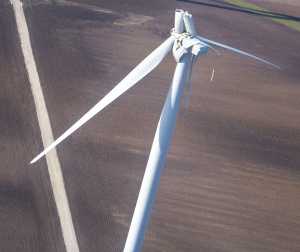| Wind Watch is a registered educational charity, founded in 2005. |
Turbine damage raises concerns for Livingston County wind farm
Credit: Michelle Chalkey | 12/04/2012 | mywebtimes.com ~~
Translate: FROM English | TO English
Translate: FROM English | TO English
In light of recent turbine damage in Vermillion and Champaign counties, Livingston County officials have raised concerns regarding the wind farm in their county.
Last week, a blade broke from one of the 134 turbines in a recently built California Ridge Wind Farm in Vermillion and Champaign counties. The turbine is near Route 49 and Vermillion County Road 2700 North, a few miles southwest of Potomac and south of Armstrong.
Chicago-based Invenergy released a statement Wednesday, saying the damage incurred was not immediately known.
“As designed, the turbine automatically ceased operation, and no one was injured in the incident,” the statement said.
This was the second turbine blade to break at wind farms in East Central Illinois this year. In June, the blade of a turbine at the Settlers Trail Wind Farm near Sheldon in Iroquois County broke.
What does this mean for Livingston County’s wind farm?
The Streator Cayuga Ridge South Wind Power Project, approximately five miles southeast of the center of Odell, consists of 150 turbines. The wind farm reached commercial operation in March 2010 and was the largest wind project in Illinois.
More than 10 percent of the blades had to be replaced within the first year of operation.
“The industries are aware of problems with the blades,” noted Judy Campbell, a Livingston County Board member. “It doesn’t become significant when counties are negotiating with the companies until damage occurs. When you hear of damage like this, it raises issues for workers’ safety. Is it safe to farm under them?” Campbell noted that each blade weighs 6,000 pounds.
County Engineer David Winters confirmed there have been several issues with the blades.
“For a fairly new operation, I’m surprised by the number of permits I’ve issued to repair blades,” Winters said. “There has been a lot of issues and maintenance work on these blades. They’ve been cracked and needed to be repaired or replaced.”
Winters noted it is only under “weird circumstances” that someone would get hurt.
“The turbines are not located in populated areas,”Winters said. “They’re set far enough back from roads that they’re not going to fall across a highway.”
Winters said the turbines leave a footprint of about an acre. In his opinion, people who are working near the turbines are the only ones in any danger, but the chances of someone getting hurt are one in a million.
“These things happen nationwide,”Winters said. “We’ve seen fires happen and blades fall off. But it’s only a remote chance that someone would get hurt. It’s one of those oddball things when you’re at the wrong place at the wrong time.”

Photo: Provided by Judy Campbell
A damaged wind turbine blade near Illinois 49 on a wind farm in Vermillion and Champaign counties.
This article is the work of the source indicated. Any opinions expressed in it are not necessarily those of National Wind Watch.
The copyright of this article resides with the author or publisher indicated. As part of its noncommercial educational effort to present the environmental, social, scientific, and economic issues of large-scale wind power development to a global audience seeking such information, National Wind Watch endeavors to observe “fair use” as provided for in section 107 of U.S. Copyright Law and similar “fair dealing” provisions of the copyright laws of other nations. Send requests to excerpt, general inquiries, and comments via e-mail.
| Wind Watch relies entirely on User Funding |
 (via Stripe) |
 (via Paypal) |
Share:

